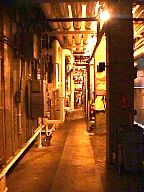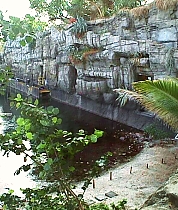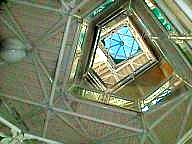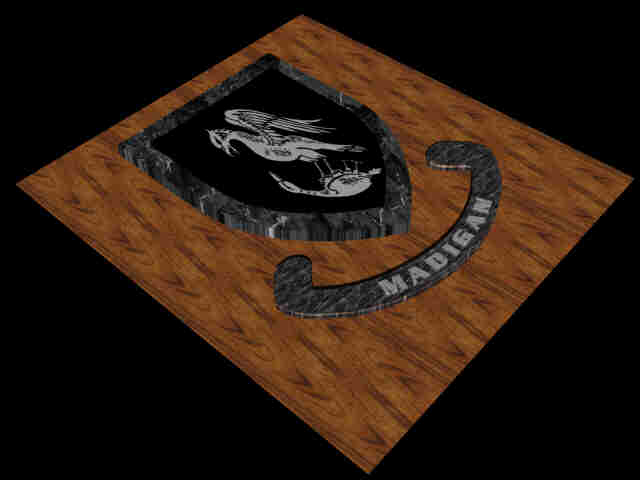We wandered along
submarine-like corridors filled with all sorts of pipes used to
carry the water recovered in collectors and re-circulate it to the
upper reaches to be recycled. The final destination of these
corridors was a fascinating building called the lung. From the
first, the engineers realized that a hermetically sealed building
would need some way to allow for the expansion and contraction of
the air within. As a result they created two sealed buildings
they called lungs that were attached to the main building by
tunnels. When the air in the Biosphere heated and expanded it
would rush down the tunnels into the lungs. Inside the lungs were
large plastic bags that each had a large aluminum disk on top of
it. When the air came into the lung it would cause the plastic
bag to expand and raise it, along with the aluminum disk. Then as
the air cooled, the weight of the aluminum disk would forcibly push the air the
other way down the tunnel back
of these
corridors was a fascinating building called the lung. From the
first, the engineers realized that a hermetically sealed building
would need some way to allow for the expansion and contraction of
the air within. As a result they created two sealed buildings
they called lungs that were attached to the main building by
tunnels. When the air in the Biosphere heated and expanded it
would rush down the tunnels into the lungs. Inside the lungs were
large plastic bags that each had a large aluminum disk on top of
it. When the air came into the lung it would cause the plastic
bag to expand and raise it, along with the aluminum disk. Then as
the air cooled, the weight of the aluminum disk would forcibly push the air the
other way down the tunnel back  into the Biosphere. Clever huh? Upon completion
of the underground tour, we began to explore the five different
eco systems supported under the glass. The first one was the
ocean. That's right, there is an ocean right in the middle.
Complete with a beach, coral, and yes, waves. It is teeming with
all kinds of fish. Twenty-five feet deep at one end, it was made
of over a million gallons of water, 10 percent of which was
actually trucked in from the Pacific Ocean. It is a paradise
lagoon in the middle of the desert. An unbelievable sight. Both
soft and hard coral grow along its bottom. It is still used for
environmental experiments. The next biome, as they are called,
that we visited was the rain forest. A steamy hot place with
broad leaf plants stretching all the way to the 90 foot ceiling.
Moisture clings to everything, in a room which is overcrowded with
leaves, vines, ferns and flowers.
into the Biosphere. Clever huh? Upon completion
of the underground tour, we began to explore the five different
eco systems supported under the glass. The first one was the
ocean. That's right, there is an ocean right in the middle.
Complete with a beach, coral, and yes, waves. It is teeming with
all kinds of fish. Twenty-five feet deep at one end, it was made
of over a million gallons of water, 10 percent of which was
actually trucked in from the Pacific Ocean. It is a paradise
lagoon in the middle of the desert. An unbelievable sight. Both
soft and hard coral grow along its bottom. It is still used for
environmental experiments. The next biome, as they are called,
that we visited was the rain forest. A steamy hot place with
broad leaf plants stretching all the way to the 90 foot ceiling.
Moisture clings to everything, in a room which is overcrowded with
leaves, vines, ferns and flowers.  Over 300 species of plants vie for space and sun
in the tallest part of the entire biosphere. There are three
different habitats, a lowland forest, a flood plain and a cloud
forest perched atop a sandstone mountain that also supports a
waterfall that cascades down the mountainside echoing through the
forest as it splashes into the pool below. There is also a
Savanna straddling the cliff and running lengthwise through the
structure. It is a complex ecology of plants from Africa, South
America and Australia. Further on there is a Marsh, modeled on
the subtropical mangrove-dominated estuary in southern Florida.
700 different trees make their home in this biome. There is even
a desert displaying its own 125 variety of plants adapted to
higher levels of humidity so as to coexist with the nearby ocean.
But the ultimate biome, the one that made it all worth while, the
one that everything was created for, was the human habitat. Here
in the center of the structure, built into a compact but
versatile area were spaces for 10 people to live and work.
Over 300 species of plants vie for space and sun
in the tallest part of the entire biosphere. There are three
different habitats, a lowland forest, a flood plain and a cloud
forest perched atop a sandstone mountain that also supports a
waterfall that cascades down the mountainside echoing through the
forest as it splashes into the pool below. There is also a
Savanna straddling the cliff and running lengthwise through the
structure. It is a complex ecology of plants from Africa, South
America and Australia. Further on there is a Marsh, modeled on
the subtropical mangrove-dominated estuary in southern Florida.
700 different trees make their home in this biome. There is even
a desert displaying its own 125 variety of plants adapted to
higher levels of humidity so as to coexist with the nearby ocean.
But the ultimate biome, the one that made it all worth while, the
one that everything was created for, was the human habitat. Here
in the center of the structure, built into a compact but
versatile area were spaces for 10 people to live and work.  Everything
from metal fabricating to medicine was needed, as well as dentistry,
woodworking, farming, mental health. If you can think of it, they
needed to do it on their own with nothing more to work with than the material on hand and the tools laid in from the beginning.
The 10 apartments were split into two story dwellings. The living
quarters were on the bottom and the bedroom was on the top. Each
person was allowed to decorate his or her domicile in whatever
way they wished. Some became libraries while others were turned
into art studios. The first physician was Dr. Roy Watford, who
kept a constant check on everybody, giving
Everything
from metal fabricating to medicine was needed, as well as dentistry,
woodworking, farming, mental health. If you can think of it, they
needed to do it on their own with nothing more to work with than the material on hand and the tools laid in from the beginning.
The 10 apartments were split into two story dwellings. The living
quarters were on the bottom and the bedroom was on the top. Each
person was allowed to decorate his or her domicile in whatever
way they wished. Some became libraries while others were turned
into art studios. The first physician was Dr. Roy Watford, who
kept a constant check on everybody, giving physicals every 8 weeks. The medical lab was
designed to minimize byproducts that caused environmental
pollution, which would contaminate the sealed system. For this
reason chemicals that harm the air and water were not use for
tests. Not all was fun and roses. In the beginning all was well
but in time, personalities grated and domestic bliss was
stretched. One of the psychological logic's was to place all the
reading material, including all reference books on how to make a
part or heal a sick plant in a library located high in a central
tower requiring the residents to make a concerted effort to climb
to get the information they needed. The theory was that it would
keep them in shape with much needed exercise while learning what
to do in solving the many problems that would be facing them. A
glass floor was installed so that those who accomplished the
climb could look down at their accomplishment. What was first
conceived as an exercise and learning program, quickly became a
chore. This disintegrated
physicals every 8 weeks. The medical lab was
designed to minimize byproducts that caused environmental
pollution, which would contaminate the sealed system. For this
reason chemicals that harm the air and water were not use for
tests. Not all was fun and roses. In the beginning all was well
but in time, personalities grated and domestic bliss was
stretched. One of the psychological logic's was to place all the
reading material, including all reference books on how to make a
part or heal a sick plant in a library located high in a central
tower requiring the residents to make a concerted effort to climb
to get the information they needed. The theory was that it would
keep them in shape with much needed exercise while learning what
to do in solving the many problems that would be facing them. A
glass floor was installed so that those who accomplished the
climb could look down at their accomplishment. What was first
conceived as an exercise and learning program, quickly became a
chore. This disintegrated  to an impossibility as food and oxygen decreased
in the final stages. Such was the fine tuning required to make
the project a success. Not everything works perfectly the first
time. So much was learned, so much was tried. Still, today all
remain great friends and two have since married each other. It
was without question, a noble endeavor by very courageous and
foresighted people, the likes of which has never been tried
before, or since. For those who would malign the lack of pioneers
on our suburban streets, sit down for a while with Ed Bass and
talk to him about adventure. We had to rush a bit towards the end
because
to an impossibility as food and oxygen decreased
in the final stages. Such was the fine tuning required to make
the project a success. Not everything works perfectly the first
time. So much was learned, so much was tried. Still, today all
remain great friends and two have since married each other. It
was without question, a noble endeavor by very courageous and
foresighted people, the likes of which has never been tried
before, or since. For those who would malign the lack of pioneers
on our suburban streets, sit down for a while with Ed Bass and
talk to him about adventure. We had to rush a bit towards the end
because  we hadn't gotten there until about 1 p.m. I
would say if anyone wanted to go, they should allow a full day to
see everything at a leisurely pace. They have a nice snack bar
and restaurant, if you get hungry along the way. One thing I
thought was very interesting is that the Biosphere II building is
under quarantine by the state of Arizona. The reason for this is
that they have brought in exotic plants from all over the world
that are not native to Arizona. They are not sure what would
happen if these plants got loose in the desert environment. So,
everyone who goes in the building goes in through an airlock and
on exiting must step into a foot bath that has disinfectant in
it. A little smelly but not bad considering it is to safeguard
their local flora and fauna. We found out that this is the only
facility in the U.S. that is a research facility, teaching facility
and tourist attraction. As we learned, they have added an
addition to that list. It seems that William Shatner was there,
filming a sci-fi movie as well. As we wended our way to our truck
at the end of the day we were tired but really felt that we had
gained a lot from our visit. If you ever get out this way be sure
and stop. It was great!
we hadn't gotten there until about 1 p.m. I
would say if anyone wanted to go, they should allow a full day to
see everything at a leisurely pace. They have a nice snack bar
and restaurant, if you get hungry along the way. One thing I
thought was very interesting is that the Biosphere II building is
under quarantine by the state of Arizona. The reason for this is
that they have brought in exotic plants from all over the world
that are not native to Arizona. They are not sure what would
happen if these plants got loose in the desert environment. So,
everyone who goes in the building goes in through an airlock and
on exiting must step into a foot bath that has disinfectant in
it. A little smelly but not bad considering it is to safeguard
their local flora and fauna. We found out that this is the only
facility in the U.S. that is a research facility, teaching facility
and tourist attraction. As we learned, they have added an
addition to that list. It seems that William Shatner was there,
filming a sci-fi movie as well. As we wended our way to our truck
at the end of the day we were tired but really felt that we had
gained a lot from our visit. If you ever get out this way be sure
and stop. It was great!
*** THE END ***

